Are you a gardener who wishes to discover new and interesting plants?
If So, here you are at the right article where you could find about Burro’s tail vs Donkey’s tail. These two plants are worth exploring.
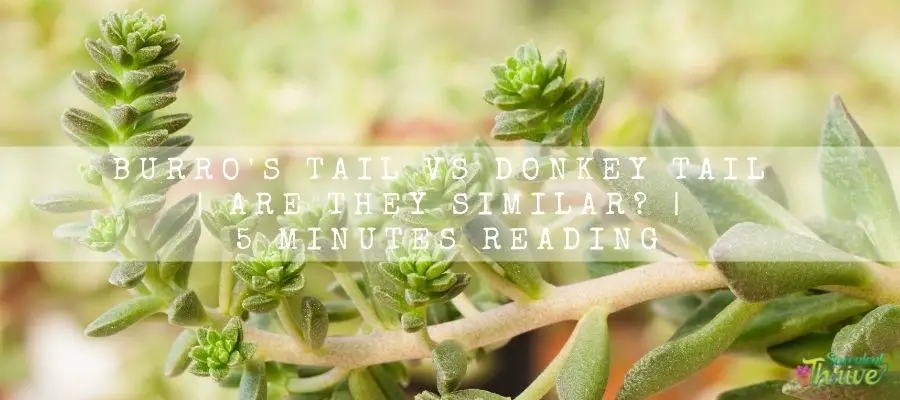
Burro’s tail (Sedum morganianum “burrito”)
If we take Burro’s tail (Sedum morganianum – burrito ) into consideration, they are very fragile and unique succulents.
When they mature, their leaves will form around the stem in a spiral way. You could spot those leaves forming in thick clusters.
They have inherited their burros tail name from their cluster formation. In fact, they tend to look like tails once those clusters are created.
If you have a head shaped planter, try growing this plant as they would perfectly suit them. Mature Burro’s tail plant stems are 2’- 4’ inches in length.
You could spot them in those lengths especially in spring and in summer.
These plants usually tend to grow in a hanging trailing manner and that is what makes them unique and adjusted in the native growing environment.
Their native growing environments would be mostly cliffs and canyons of southern Mexico.
In addition to that, many people are so keen on growing them as houseplants due to their unique looks.
As aforesaid they are fragile plants. Therefore, their fragile leaves could break off at the slightest touch. However, they could root at a faster rate, and they could produce pups easier than most succulents.
It can be somewhat challenging to keep them perfect in their looks due the fragility of the leaves, particularly if you have kept them on a shelf or if you have hung them.
However, though they drop leaves, they have naturally structured branches to fill the gap.
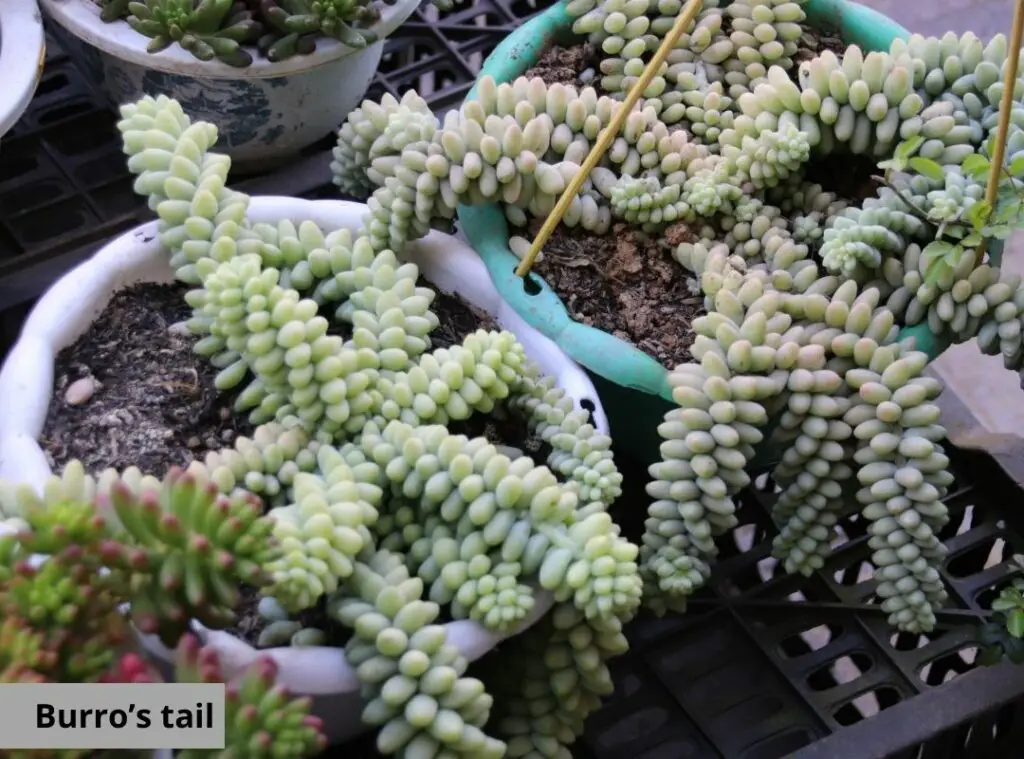
Donkey tail (Sedum morganianum)
Donkey tail plant looks so similar to burro’s tail plant. Donkey tail also consists of thick ,pendant stems. Further they would be green to gray green.
Chances are that you could spot them in blue green as well. Usually their stms form from the base and could rise to 1 m in height. Leaves could be 2 cm in length and 0.8 cm in width.
They almost look like burrito tails, however you could identify the donkey tail due to longer pointier leaves.
They will produce flowers in purplish pink to red purple. You could expect them to flower in spring. Moreover they would form in pendant clusters at the stem edges.
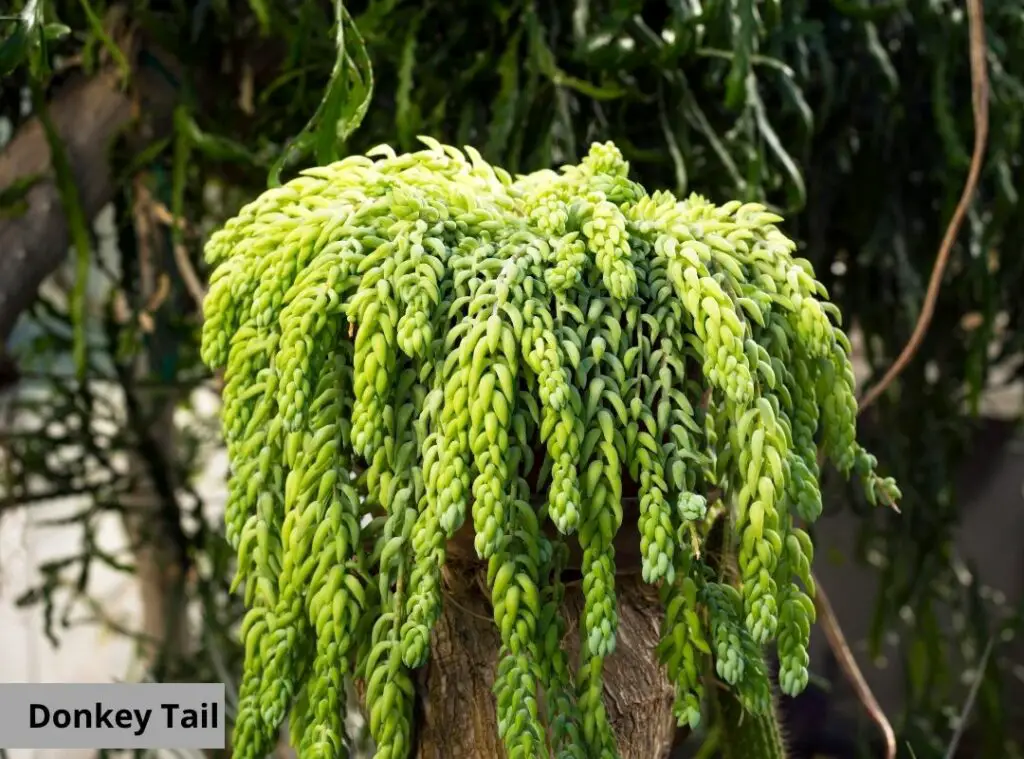
Similarities between Burro’s tail vs donkey tail
People find it difficult to identify whether burrito is a variation or a mutation of Sedum morganianum or whether it is its own species.
Many people sell both these plants as Sedum morganianum Both these plants are coming from Southern Mexico. However, botanists did not find burro’s tail until the mid-1970s.
Both these plants would require a high level of sunlight and minimal watering to thrive well.
You could grow both donkey’s tail and burrito in hanging baskets or even in containers so that you could let them grow in a trailing manner.
In addition to that, you should provide a well draining soil mix for both plants to grow well. Burrito and donkey’s tail are non toxic for pets and for humans,
However it is recommended to avoid kids from consuming the bot plants.
Differences between Burro’s tail vs donkey tail
Donkey’s tail would contain lance shaped leaves as mentioned above. They would form in a loose clustered way around the stem.
Moreover donkey’s tail leaves would be longer pointied. On the other hand, a burrito would contain leaves which are more round and bead in shape.
They would mostly form in a tightly packed manner around the stem. Besides the leaf shape, you could spot a great difference when you look at them virtually.
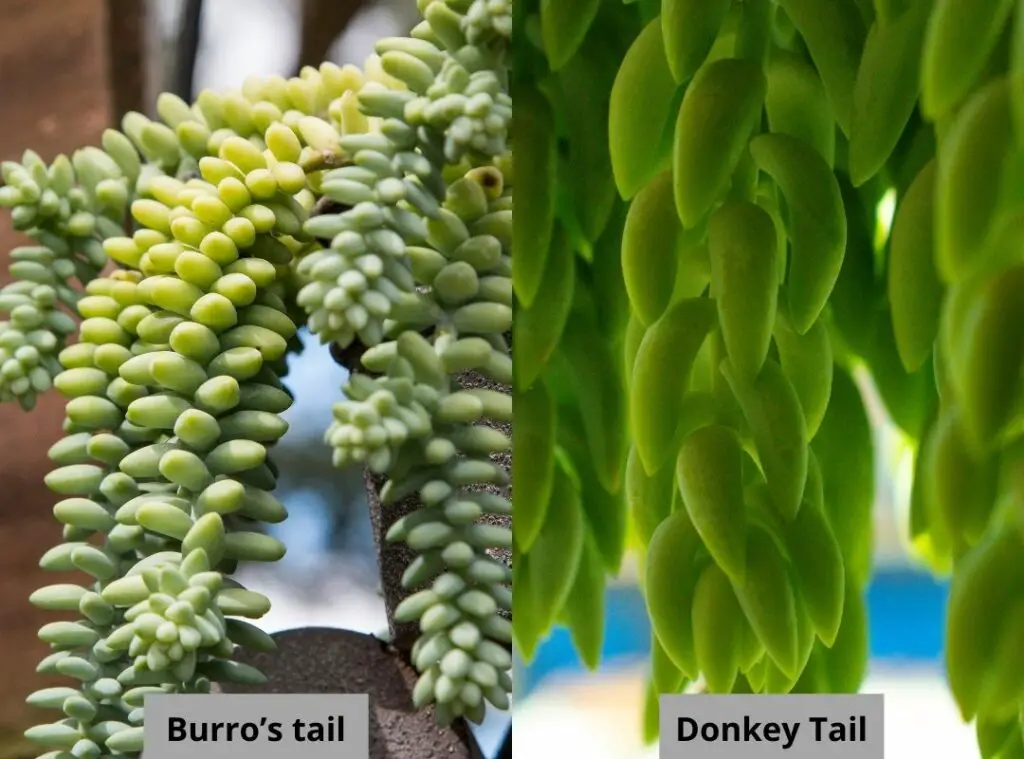
How to care for burro’s tail
Light requirement
If you are growing them indoors, you could grow them by a bright sunny window.
Having said that, you need to avoid exposing them to intense sunlight unless there could be sunburns in the plant.
Alternatively, you could bring them outdoors during the summer season.
However, you need to ascertain that you are placing them somewhere where they get bright sunlight in the morning and partial sunlight in the afternoon hours.
On the other hand, the exposure of too intense sunlight for prolonged periods for these plants would result in dis-color and burns in the plant.
Having said that, it is essential that they get high levels of sunlight for their vigorous growth and for cluster formation as well.
In case your plant’s leaves are growing with a huge gap between the leaves and if your plant is becoming leggy and tall, you need to expose the plant for full sunlight gradually.
Instead of that you may also place them under a grow light too.
Watering requirement
In terms of watering, it would vary depending on the material and on the size of the pot.
In addition to that, soil quality and the location where you have placed the plant will also affect in adjusting the water volume and the frequency in watering.
Finally, humidity level also impacts watering these plants. Having said that, you could consider watering them once every fortnight.
When watering them, you need to ensure that you are letting the soil dry between two watering sessions. On the other hand, cut back on watering them during the winter season.
If you underwater them, they could drop the leaves as they become hydrated. In case they form wrinkled leaves, it is the time you need to consider watering them.
Soil requirement
Make sure that you are growing them in a well-draining soil mix. You could consider providing them with cactus food during their growing season.
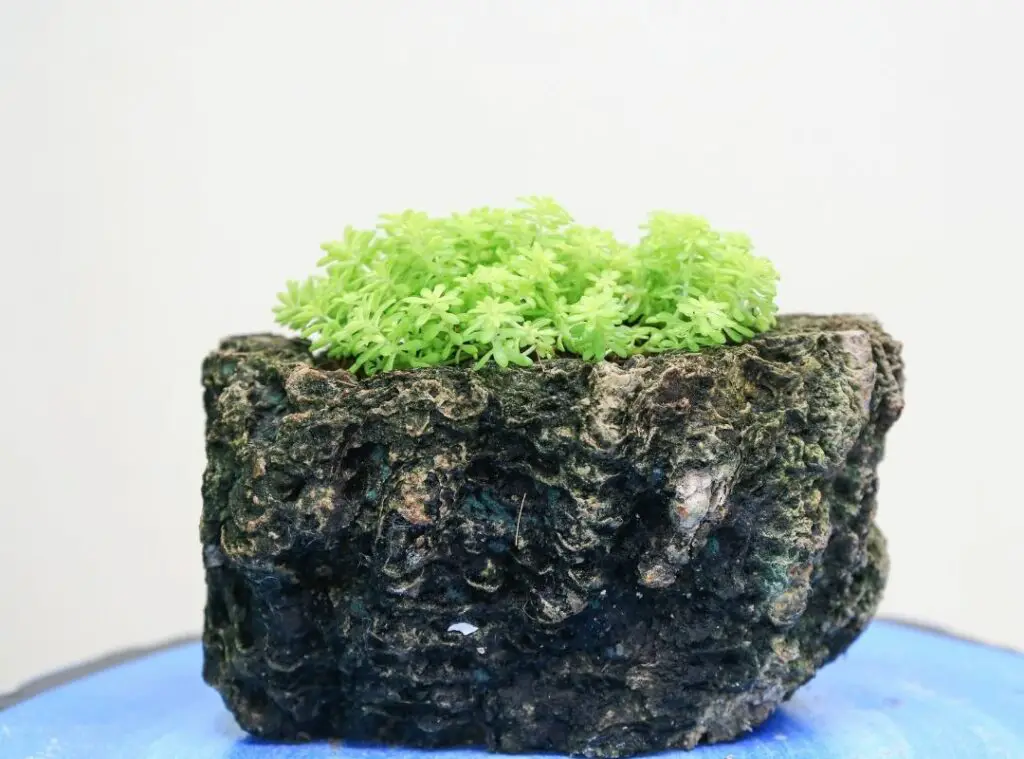
How to care for Donkey tail
Light requirement
When taking care of the donkey tail plants, you could provide them bright sunlight during spring as that would be quite beneficial for the plants blooming.
When you are keeping a donkey tail plant outdoors or indoors during the rest of the seasons, ideally, they need to get bright sunlight for six hours and partial sunlight for the rest.
Watering requirement
Avoid over watering these plants. You could consider watering them once or twice a month so that they could grow vigorously.
However, you need to always check whether their soil is dry before you water them.
Soil requirement
Make sure that you have grown them in a well-draining gritty soil mix unless chances are that the plant will end up having root rot. You could consider providing a balanced organic fertilizer during their growing season.
How do you propagate a donkey tail plant?
Propagation through leaves
You could use their leaves to propagate the donkey’s tail plant. However, leaf propagation would take more time when compared to the stem cutting method.
Moreover, you cannot guarantee the results coming from this method also.
Having said that, if you wish to multiply plants, you could consider using the leaf propagation. If you go ahead with this method, ensure the selected leaves are plump and healthy too.
Moreover, use a whole leaf without leaving any part of it on the plant. After that you could let those become dry and plant them.
Propagation through stem cuttings
Best is to use the stem cutting method to propagate donkey tail plants.
To start off you need to obtain the cuttings first. When choosing them, ensure that you are using plump and healthy stems. Avoid using dehydrated stems.
Next, leave those cuttings to wither for some time. So that they could heal. Moreover, you should keep them in a dry place without exposing them to direct sunlight.
Optionally you could dip those cuttings in a rooting hormone as well. it could be useful in boosting the success of the rooting and the propagation process.
Arrange a well-draining soil mix. When the cuttings are dry, you could place them in the soil. After some time, you will see how they form roots and later how they form new growth as well.
Usually within two weeks’ time, you could spot them rooting. Water them when the soil is dry.
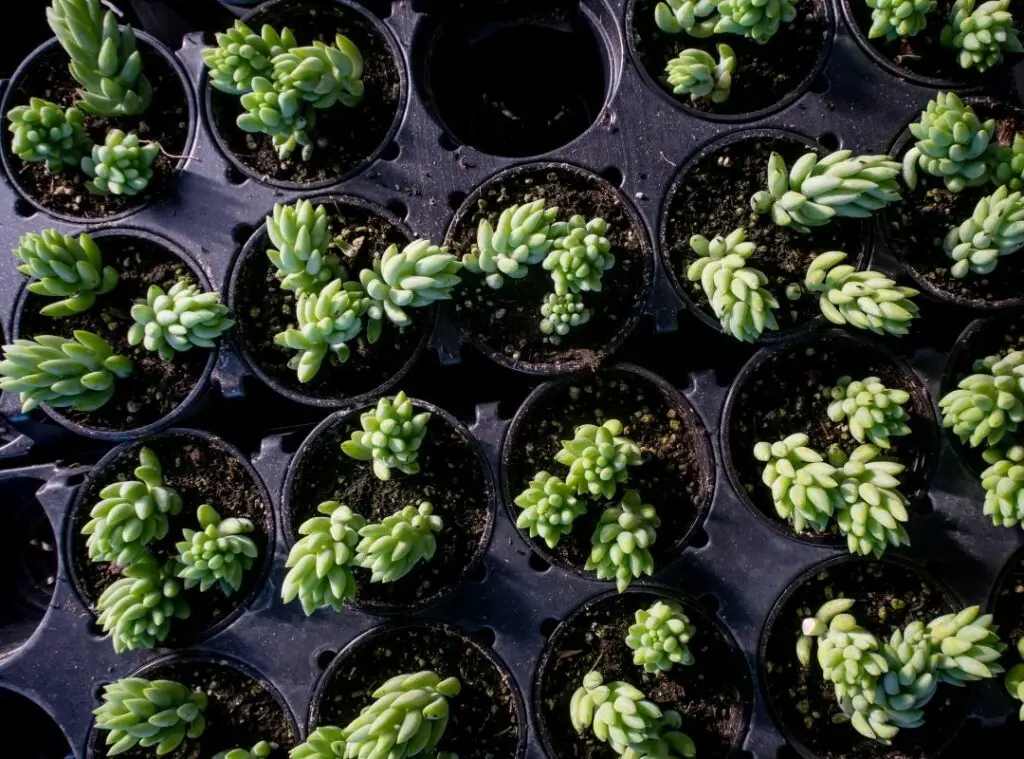
Related question
Does the donkey tail like full sun?
Donkey tail plants would require bright sunlight to partial sunlight. When we say bright sunlight, if you expose them for about six hours of bright sunlight, that would be enough for them to thrive well .
Avoid exposing them to the scorching sun for too long as aforesaid.
Is burro’s tail toxic to cats?
These are not toxic plants for cats.
Is Donkey tail toxic?
Just like the Burro’s tail, the donkey tail is also not poisonous.
How long does it take for a burro’s tail to grow?
It would take about six years for a burro’s tail plant to grow.
Conclusion
Now you know there is not much difference between burro’s tail vs donkey tail succulents. You can identify them apart by looking at the plant and its leaves.
You may also understand how fun it is to grow both these plants. You could consider growing them as houseplants since they are not toxic for pets and for humans as well.
Best is to grow them in hanging baskets as they would perfectly fit in those. It will be a treat to watch them growing.
Read More: 10 Drought Tolerant Succulents For Extreme Weather
